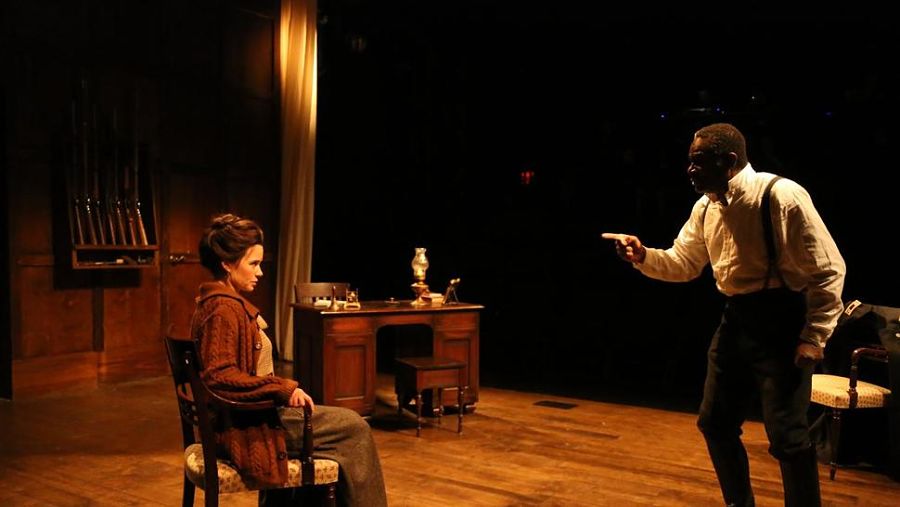Ibsen: “Marriage! Nothing else demands so much of a man.”
Strindberg: “Love between a man and woman is war.”
Rarely have two plays been paired as effectively as A Doll’s House and The Father, two Scandinavian classics that recently played in repertory at Theatre for a New Audience’s exciting space in Brooklyn (they ran Apr. 30-June 12). Written only eight years apart (1879 and 1887, respectively), these late-19th-century masterpieces about marriage, seen side by side, have a stunning impact, offering penetrating, perturbing insights into the complexities of this social institution that resonate resoundingly today.
Moreover, they raise tantalizing questions about the intent of their respective authors, Henrik Ibsen and August Strindberg—contemporaries and rivals with a fierce love/hate relationship—not to mention curiosity about the source of these two plays in their own personal lives and relationships with women.
In A Doll’s House, a play that has been performed around the world as frequently as any by Shakespeare or Chekhov, a woman defies society and convention by leaving her husband because she cannot stay in the marriage and be true to herself. In The Father, a husband is driven mad by doubts planted in his mind by his wife as to his parentage of their only daughter, whose education and future he is determined to control. Both plays deal with the injustices that marriage imposes on women, and their lack of authority, equality, status and control both in society and in the home. And both dramatize titanic struggles between the husband and wife, with the latter triumphing in the end.
Or does she? And what kind of a victory is it? Seen side by side, these two provocative plays end up raising more questions than they answer—and therein lay the power of the pairing.
Fueled by fascination, I sat down with Arin Arbus, the brilliant young director whose brainchild it was to stage them together, and who did so with artistry and alacrity. Associate artistic director at TFANA since 2009, Arbus spoke of the genesis of this ambitious project, its challenges, and its discoveries.
CAROL ROCAMORA: What is the source of inspiration in your pairing of these plays?

ARIN ARBUS: Initially, I was interested in the two plays separately, and didn’t realize how directly related they were. Then I started to find some interesting connections. Both plays are Scandinavian, both focus on marriage, both are set at Christmastime. Both are three act plays with a final climax; there’s Nora, there’s Laura, and so on. Then I did the research: The Father was actually Strindberg’s rebuttal to Ibsen’s A Doll House. As a young playwright, Strindberg worshipped the older Ibsen—but after he saw A Doll’s House, he was outraged by what he considered to be a scandalous attack on the male sex. In his collection of writings called Getting Married, Strindberg dedicates eight pages to a scene-by-scene analysis of the play, calling Nora a hussy and Torvald innocent. Strindberg even wrote a short story called “A Doll’s House” about a couple torn apart because the wife gets hold of a copy of the play and reads it!
Strindberg called Doll’s House “swinery” and its author “a decrepit old troll” and an “ignorant women’s writer.” Apparently, the clash between the writers became personal.
Strindberg insists that his battle with Ibsen cost him his marriage, his children, his fortune and his career! Meanwhile, in response, Ibsen bought a portrait of Strindberg and placed it over his desk. Ibsen is reported to have said: “That lunatic is my mortal enemy and he will watch every word that I write!”
At the same time, they’re both drawing from their own personal relationships with women. Ibsen had a friend named Laura Kieler who, like his character Nora, needed to borrow money to save her husband’s health but couldn’t because of Norwegian law. She turned to Ibsen, who refused to help her. As a result she forged a check—and was found out. That’s the basis of A Doll’s House.
Strindberg was married three times. Early on he was passionate about women’s causes, but after his first marriage (to a woman named Siri) he became violently anti-feminist! Evidently, Siri had an affair during their marriage, so Strindberg never was sure if their children were, in fact, his…
Just like the Captain in The Father.
Yes. Both plays are ultimately about the cost of marriage on the children. But if Strindberg felt only hatred for women, he wouldn’t have been able to write any of his plays. The problem is that, at the same time, he also feels extreme love and need for women. He’s in awe of women; he marries three of them and then hates them and fights with them and gets driven crazy by them. His life was a mess—and that’s what makes him such a great playwright.
These striking similarities must have facilitated your casting of one ensemble to perform in both. You have a parallel pair of marriages, with two traditional, controlling husbands, Torvald and the Captain, and two wives, Nora and Laura, who find the strength to stand up to them.
We don’t have a fixed company, but one of artistic director Jeffrey Horowitz’s great gifts is developing relationships with artists who return again and again. I knew John Douglas Thompson could play the Captain in The Father—he’s such a heroic, big-hearted leading man. On the other hand, I thought the role of Torvald wasn’t in his wheelhouse: Torvald is empty; he cares only about appearances. But knowing what a great actor John is, I was interested in seeing him in the role. After all, the play doesn’t work unless you get on board with Nora and Torvald’s marriage for a while. And of course Maggie Lacey is so convincing in both parts. The process was challenging for the entire company: We rehearsed The Father for two and a half weeks and then A Doll’s House for two and a half weeks. We all felt schizophrenic. Strindberg makes you feel sort of slimy, so to go from one world to another is tough—but thrilling.

Your choice of the “traverse” configuration in the new TFANA space is an inspired one, with the audience seated on either side of these claustrophobic households, peering through gossamer curtains (in A Doll’s House) or through smoke (The Father) into explosive scenes of domestic violence.
It was a challenge to find a design to work for both plays. Riccardo Hernandez, the set designer, wanted The Father to feel like a boxing ring, so at first we wanted to stage it in the round. But for A Doll’s House you need doors. So the traverse configuration felt right. It’s like a sporting event—men versus women, Ibsen versus Strindberg. These plays are about entrapment, and that’s reflected in the set.
How did you choose the translations/adaptations?
Jeffrey knew of the Thornton Wilder adaptation of A Doll’s House. I read it and loved how concise it is. Wilder strips it to the essentials, and it feels very conversational and contemporary. Strindberg is tricky to translate. Jeffrey and I had admired David Greig’s adaptation of Strindberg’s The Creditors, so we reached out to David and commissioned it. It was fantastic to work with him in rehearsal, and discover what’s really happening in each scene. For me it was essential to have someone who could sculpt the play. It needed it.
You embraced the melodrama of both pieces, and with your fast-paced, high-pitched direction, it was as thrilling, breathtaking ride. What was the audience’s response to the pairing?
The Father inspired hissing and booing at the misogyny of the play. There was clapping, gasping, laughter, and even cheering at crucial moments—it was wild! Audiences emerge polarized, some hating one character in The Father and some hating the other. Ibsen doesn’t have this effect. Because Ibsen was sane, he had a sane effect on audiences, and the response to A Doll’s House was more civilized. And of course there was applause at the final exchange:
Torwald: But no man would sacrifice his honor for the one he loves!
Nora: It is a thing hundreds of thousands of women have done!
What did you learn about both plays, in retrospect?
It’s true that both were writing about “the woman’s question”—the big issue of the day. But once you look at the plays together, they seem to be writing about different things. Ibsen is writing about society—he’s a social critic, saying that if we could change our corrupt society, then men and women could create a true marriage. Strindberg, on the other hand, is writing about his perception of nature and human nature—namely the Darwinian battle between men and women, who are fundamentally different and who will always be at war with each other. Strindberg tried to reduce drama to its most elemental form. His characters may have been living in a civilized society, but they are ripping each other apart like animals, ferociously, psychologically.
You’re known for your accomplished direction of Shakespeare. How has this experience helped you grow as an artist?
These are the first Off-Broadway shows I’ve directed that have not been Shakespeare. I’ve been doing Shakespeare at TFANA since 2009. Meanwhile, I’ve been wanting to work on other great writers, so this was exciting. My muscles are bigger as a result. And I feel I am closer to Ibsen and Strindberg as a result.


